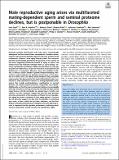Files in this item
Male reproductive aging arises via multifaceted mating-dependent sperm and seminal proteome declines, but is postponable in Drosophila
Item metadata
| dc.contributor.author | Sepil, Irem | |
| dc.contributor.author | Hopkins, Ben R. | |
| dc.contributor.author | Dean, Rebecca | |
| dc.contributor.author | Bath, Eleanor | |
| dc.contributor.author | Friedman, Solomon | |
| dc.contributor.author | Ben Swanson | |
| dc.contributor.author | Ostridge, Harrison J. | |
| dc.contributor.author | Harper, Lucy | |
| dc.contributor.author | Buehner, Norene A. | |
| dc.contributor.author | Wolfner, Mariana F. | |
| dc.contributor.author | Konietzny, Rebecca | |
| dc.contributor.author | Thezenas, Marie-Laetitia | |
| dc.contributor.author | Sandham, Elizabeth | |
| dc.contributor.author | Charles, Philip D. | |
| dc.contributor.author | Fischer, Roman | |
| dc.contributor.author | Steinhauer, Josefa | |
| dc.contributor.author | Kessler, Benedikt M. | |
| dc.contributor.author | Wigby, Stuart | |
| dc.date.accessioned | 2020-08-10T09:30:03Z | |
| dc.date.available | 2020-08-10T09:30:03Z | |
| dc.date.issued | 2020-07-21 | |
| dc.identifier | 269528151 | |
| dc.identifier | a65df227-f53f-44b4-94b8-3edd45c8f650 | |
| dc.identifier | 000553294300004 | |
| dc.identifier | 32611817 | |
| dc.identifier | 85088879346 | |
| dc.identifier.citation | Sepil , I , Hopkins , B R , Dean , R , Bath , E , Friedman , S , Ben Swanson , Ostridge , H J , Harper , L , Buehner , N A , Wolfner , M F , Konietzny , R , Thezenas , M-L , Sandham , E , Charles , P D , Fischer , R , Steinhauer , J , Kessler , B M & Wigby , S 2020 , ' Male reproductive aging arises via multifaceted mating-dependent sperm and seminal proteome declines, but is postponable in Drosophila ' , Proceedings of the National Academy of Sciences of the United States of America , vol. 117 , no. 29 , pp. 17094-17103 . https://doi.org/10.1073/pnas.2009053117 | en |
| dc.identifier.issn | 0027-8424 | |
| dc.identifier.uri | https://hdl.handle.net/10023/20436 | |
| dc.description | I.S. and S.W. were supported by a Biotechnology and Biological Sciences Research Council (BBSRC) Fellowship to S.W. (BB/K014544/1) and S.W. additionally by a Dresden Senior Fellowship. B.M.K., P.D.C., and R.F. were supported by the Kennedy Trust and John Fell Funds. R.D. was supported by Marie Curie Actions (Grant 655392). B.R.H. was funded by the EP Abraham Cephalosporin-Oxford Graduate Scholarship with additional support from the BBSRC Doctoral Training Programme. M.F.W. was supported by a NIH Grant R01HD038921. Work in the J.S. Laboratory was supported by NIH Grant R15HD080511. | en |
| dc.description.abstract | Declining ejaculate performance with male age is taxonomically widespread and has broad fitness consequences. Ejaculate success requires fully functional germline (sperm) and soma (seminal fluid) components. However, some aging theories predict that resources should be preferentially diverted to the germline at the expense of the soma, suggesting differential impacts of aging on sperm and seminal fluid and trade-offs between them or, more broadly, be-tween reproduction and lifespan. While harmful effects of male age on sperm are well known, we do not know how much seminal fluid deteriorates in comparison. Moreover, given the predicted trade-offs, it remains unclear whether systemic lifespan-extending inter-ventions could ameliorate the declining performance of the ejacu-late as a whole. Here, we address these problems using Drosophila melanogaster. We demonstrate that seminal fluid deterioration con-tributes to male reproductive decline via mating-dependent mech-anisms that include posttranslational modifications to seminal proteins and altered seminal proteome composition and transfer. Additionally, we find that sperm production declines chronologically with age, invariant to mating activity such that older multiply mated males become infertile principally via reduced sperm transfer and viability. Our data, therefore, support the idea that both germline and soma components of the ejaculate contribute to male reproduc-tive aging but reveal a mismatch in their aging patterns. Our data do not generally support the idea that the germline is prioritized over soma, at least, within the ejaculate. Moreover, we find that lifespan-extending systemic down-regulation of insulin signaling re-sults in improved late-life ejaculate performance, indicating simul-taneous amelioration of both somatic and reproductive aging. | |
| dc.format.extent | 10 | |
| dc.format.extent | 8481799 | |
| dc.language.iso | eng | |
| dc.relation.ispartof | Proceedings of the National Academy of Sciences of the United States of America | en |
| dc.subject | Seminal fluid | en |
| dc.subject | Sperm | en |
| dc.subject | Aging | en |
| dc.subject | Fertility | en |
| dc.subject | Fitness | en |
| dc.subject | QH301 Biology | en |
| dc.subject | DAS | en |
| dc.subject.lcc | QH301 | en |
| dc.title | Male reproductive aging arises via multifaceted mating-dependent sperm and seminal proteome declines, but is postponable in Drosophila | en |
| dc.type | Journal article | en |
| dc.contributor.institution | University of St Andrews. School of Biology | en |
| dc.identifier.doi | https://doi.org/10.1073/pnas.2009053117 | |
| dc.description.status | Peer reviewed | en |
This item appears in the following Collection(s)
Items in the St Andrews Research Repository are protected by copyright, with all rights reserved, unless otherwise indicated.

